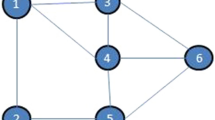Abstract
In this paper, we proposed a quality of transmission (QoT) prediction technique for the quality of service (QoS) link setup based on machine learning classifiers, with synthetic data generated using the transmission equations instead of the Gaussian noise (GN) model. The proposed technique uses some link and signal characteristics as input features. The bit error rate (BER) of the signals was compared with the forward error correction threshold BER, and the comparison results were employed as labels. The transmission equations approach is a better alternative to the GN model (or other similar margin-based models) in the absence of real data (i.e., at the deployment stage of a network) or the case that real data are scarce (i.e., for enriching the dataset/reducing probing lightpaths); furthermore, the three classifiers trained using the data of the transmission equations are more reliable and practical than those trained using the data of the GN model. Meanwhile, we noted that the priority of the three classifiers should be support vector machine (SVM) >K nearest neighbor (KNN) > logistic regression (LR) as shown in the results obtained by the transmission equations, instead of SVM > LR > KNN as in the results of the GN model.

Similar content being viewed by others
References
Kulkarni P, Tzanakaki A, Machuka C M, Tomkos I. Benefits of Q-factor based routing in WDM metro networks. In: Proceedings of European Conference on Optical Communication (ECOC). Glasgow: IET, 2005, Th3.5.7
Feng Q, Li W, Zheng Q, Wang Y, Hu C, Xie Y, Lian W. The OTDR with high dynamic range based on LFM signal and FDM. IEEE Photonics Technology Letters, 2020, 32(7): 359–362
Hu C, Li W, Zheng H, Feng Q, Zheng Q, Wang Y. A novel cost-effective and distributed in-band OSNR monitoring method using Gaussian process regression. IEEE Photonics Journal, 2019, 11(4): 720431
Pachnicke S, Paschenda T, Krummrich P M. Physical impairment based regenerator placement and routing in translucent optical networks. In: Proceedings of Optical Fiber Communication Conference. San Diego: IEEE, 2008, OWA2
Markidis G, Sygletos S, Tzanakaki A, Tomkos I. Impairment-constraint-based routing in ultralong-haul optical networks with 2R regeneration. IEEE Photonics Technology Letters, 2007, 19(6): 420–422
Politi C T, Anagnostopoulos V, Matrakidis C, Stavdas A. Physical layer impairment aware routing algorithms based on analytically calculated Q-factor. In: Proceedings of Optical Fiber Communication Conference. Anaheim: IEEE, 2006, OFG1
Barletta L, Giusti A, Rottondi C, Tornatore M. QoT estimation for unestablished lighpaths using machine learning. In: Proceedings of Optical Fiber Communication Conference. Los Angeles: IEEE, 2017, Th1J.1
Zheng Q, Li W, Yan R, Feng Q, Xie Y, Wang Y. XPM mitigation in WDM systems using split nonlinearity compensation. IEEE Photonics Journal, 2019, 11(6): 7205411
Zheng Q, Yuan Z, Li Y, Li W. Optimization of split transmitter-receiver digital nonlinearity compensation in Bi-directional Raman unrepeatered system. Applied Sciences (Basel, Switzerland), 2018, 8(6): 972
Shao J, Liang X, Kumar S. Comparison of split-step Fourier schemes for simulating fiber optic communication systems. IEEE Photonics Technology Letters, 2014, 6(4): 7200515
Poggiolini P, Bosco G, Carena A, Curri V, Jiang Y, Forghieri F. The GN-model of fiber non-linear propagation and its applications. Journal of Lightwave Technology, 2014, 32(4): 694–721
Mo W, Huang Y, Zhang S, Ip E, Kilper D C, Aono Y, Tajima T. ANN-based transfer learning for QoT prediction in real-time mixed line-rate systems. In: Proceedings of Optical Fiber Communication Conference. San Diego: IEEE, 2018, W4F.3
Mata J, Miguel I D, Durán R J, Aguado J C, Merayo N, Ruiz L, Fernández P, Lorenzo R M, Abril E J, Tomkos I. Supervised machine learning techniques for quality of transmission assessment in optical networks. In: Proceedings of International Conference on Transparent Optical Networks (ICTON). Bucharest: IEEE, 2018, We.B3.5
Morais R M, Pedro J. Evaluating machine learning models for QoT estimation. In: Proceedings of International Conference on Transparent Optical Networks (ICTON). Bucharest: IEEE, 2018, Tu.A3.4
Bouda M, Oda S, Akiyama Y, Paunovic D, Hoshida T, Palacharla P, Ikeuchi T. Demonstration of continuous improvement in open optical network design by QoT prediction using machine learning. In: Proceedings of Optical Fiber Communication Conference. San Diego: IEEE, 2019, M3Z.2
Panayiotou T, Savva G, Shariati B, Tomkos I, Ellinas G. Machine learning for QoT estimation of unseen optical network states. In: Proceedings of Optical Fiber Communication Conference. San Diego: IEEE, 2019, Tu2E.2
Azzimonti D, Rottondi C, Tornatore M. Using active learning to decrease probes for QoT estimation in optical networks. In: Proceedings of Optical Fiber Communication Conference. San Diego: IEEE, 2019, Th1H.1
Aladin S, Tremblay C. Cognitive tool for estimating the QoT of new lightpaths. In: Proceedings of Optical Fiber Communication Conference. San Diego: IEEE, 2018, M3A.3
Morais R M, Pedro J. Machine learning models for estimating quality of transmission in DWDM networks. Journal of Optical Communications and Networking, 2018, 10(10): D84–D99
Dar R, Feder M, Mecozzi A, Shtaif M. Accumulation of nonlinear interference noise in fiber-optic systems. Optics Express, 2014, 22(12): 14199–14211
Acknowledgements
This work was supported by the Open Foundation of China Southern Power Grid Co., Ltd.
Author information
Authors and Affiliations
Corresponding authors
Rights and permissions
About this article
Cite this article
Fu, Y., Chen, J., Wu, W. et al. A QoT prediction technique based on machine learning and NLSE for QoS and new lightpaths in optical communication networks. Front. Optoelectron. 14, 513–521 (2021). https://doi.org/10.1007/s12200-020-1079-y
Received:
Accepted:
Published:
Issue Date:
DOI: https://doi.org/10.1007/s12200-020-1079-y




